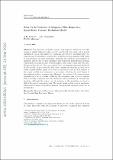Files in this item
Solar cycle variation of magnetic flux ropes in a quasi-static coronal evolution model
Item metadata
| dc.contributor.author | Yeates, A. R. | |
| dc.contributor.author | Constable, J. A. | |
| dc.contributor.author | Martens, P. C. H. | |
| dc.date.accessioned | 2016-06-22T15:30:03Z | |
| dc.date.available | 2016-06-22T15:30:03Z | |
| dc.date.issued | 2010-05 | |
| dc.identifier | 243585732 | |
| dc.identifier | e6a0abc3-6e02-4959-9edc-ff38fd5f170f | |
| dc.identifier | 77951975057 | |
| dc.identifier.citation | Yeates , A R , Constable , J A & Martens , P C H 2010 , ' Solar cycle variation of magnetic flux ropes in a quasi-static coronal evolution model ' , Solar Physics , vol. 263 , no. 1 , pp. 121-134 . https://doi.org/10.1007/s11207-010-9546-z | en |
| dc.identifier.issn | 0038-0938 | |
| dc.identifier.other | ArXiv: http://arxiv.org/abs/1003.4653v1 | |
| dc.identifier.uri | https://hdl.handle.net/10023/9037 | |
| dc.description.abstract | The structure of electric current and magnetic helicity in the solar corona is closely linked to solar activity over the 11-year cycle, yet is poorly understood. As an alternative to traditional current-free "potential field" extrapolations, we investigate a model for the global coronal magnetic field which is non-potential and time-dependent, following the build-up and transport of magnetic helicity due to flux emergence and large-scale photospheric motions. This helicity concentrates into twisted magnetic flux ropes, which may lose equilibrium and be ejected. Here, we consider how the magnetic structure predicted by this model-in particular the flux ropes-varies over the solar activity cycle, based on photospheric input data from six periods of cycle 23. The number of flux ropes doubles from minimum to maximum, following the total length of photospheric polarity inversion lines. However, the number of flux rope ejections increases by a factor of eight, following the emergence rate of active regions. This is broadly consistent with the observed cycle modulation of coronal mass ejections, although the actual rate of ejections in the simulation is about a fifth of the rate of observed events. The model predicts that, even at minimum, differential rotation will produce sheared, non-potential, magnetic structure at all latitudes. | |
| dc.format.extent | 14 | |
| dc.format.extent | 2485217 | |
| dc.language.iso | eng | |
| dc.relation.ispartof | Solar Physics | en |
| dc.rights | © 2010, Springer. This work is made available online in accordance with the publisher’s policies. This is the author created, accepted version manuscript following peer review and may differ slightly from the final published version. The final published version of this work is available at link.springer.com / https://dx.doi.org/10.1007/s11207-010-9546-z | en |
| dc.subject | Coronal mass ejections, theory | en |
| dc.subject | Magnetic fields, corona | en |
| dc.subject | Magnetic fields, models | en |
| dc.subject | Solar cycle, models | en |
| dc.subject | QB Astronomy | en |
| dc.subject | QC Physics | en |
| dc.subject.lcc | QB | en |
| dc.subject.lcc | QC | en |
| dc.title | Solar cycle variation of magnetic flux ropes in a quasi-static coronal evolution model | en |
| dc.type | Journal article | en |
| dc.contributor.sponsor | Science & Technology Facilities Council | en |
| dc.contributor.institution | University of St Andrews.Applied Mathematics | en |
| dc.identifier.doi | 10.1007/s11207-010-9546-z | |
| dc.description.status | Peer reviewed | en |
| dc.identifier.grantnumber | ST/H008799 | en |
This item appears in the following Collection(s)
Items in the St Andrews Research Repository are protected by copyright, with all rights reserved, unless otherwise indicated.

